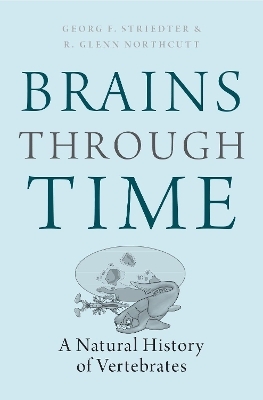
Brains Through Time
Oxford University Press Inc (Verlag)
978-0-19-512568-9 (ISBN)
When did the first vertebrates emerge, and how did they differ from their invertebrate ancestors? When did vertebrates evolve jaws, paired fins, pattern vision, or a neocortex? How have evolutionary innovations such as these impacted vertebrate behavior and success? Georg Striedter and Glenn Northcutt answer these fundamental questions about all major vertebrate lineages. Highlighting the key innovations of each major taxonomic group, they review how evolutionary changes in vertebrate genetics, anatomy, and physiology are reflected in the nervous system. This highly accessible book allows readers to explore a vast expanse of scientific knowledge, ranging from paleoecology to comparative molecular biology, sensory biology to neural circuit evolution, and fossil anatomy to animal behavior.
Brains Through Time examines how vertebrate nervous systems evolved in conjunction with other organ systems and the planet's ecology. Surveying an enormous range of information on genes and proteins, sensory and motor systems, central neural circuits, physiology, and animal behavior, the authors reconstruct the major changes that occurred as vertebrates emerged and then diversified. In the process, readers are transported back in time to key stages of vertebrate evolution, notably the origin of vertebrates, the evolution of paired fins and jaws, the transition to life on land, and the origins of warm-blooded mammals and birds.
Georg F. Striedter is Professor in the Department of Neurobiology and Behavior at the University of California, Irvine. He is the author of Neurobiology: A Functional Approach (2015) and Principles of Brain Evolution (2004). R. Glenn Northcutt is Professor in the Department of Neuroscience at the Unviersity of California, San Diego.
Chapter 1 - Reconstructing History: Aims and Methodology
1.1 - Comparative Approaches Outside of Biology
1.2 - The Comparative Method in Biology
1.3 - Comparative Approaches in Neurobiology
1.4 - The Importance of Natural History
Chapter 2 - The origin of vertebrates: invertebrate chordates and cyclostomes
2.1 - The Origins of Neurons and Nervous Systems
2.2 - Basal Vertebrates and their Closest Invertebrate Relatives
2.3 - The Paleoecology of Early Chordates
2.4 - The Major Sense Organs of Early Vertebrates
2.5 - Movements and Motor Control
2.6 - Early Vertebrate Brains
2.7 - Developmental Mechanisms for Evolving a "New Head"
2.8 - The Question of Novelty in Evolution
Chapter 3 - The origin of jaws and paired fins: the age of fishes
3.1 - Extant Jawed Fishes and Their Brains
3.2 - The Paleoecology of Early Gnathostomes
3.3 - The Sense Organs of Early Gnathostomes
3.4 - Gnathostome Movements and Motor Control
3.5 - The Brains of Early Jawed Fishes
3.6 - Evolutionary Changes in Telencephalic Connections
3.7 - Functional Synthesis
Chapter 4 - The Invasion of Land: Lobe-finned Fishes and Amphibians
4.1 - The Lobe-finned Vertebrates
4.2 - Challenges and Opportunities on Land
4.3 - Sense Organs for Use on Land
4.4 - Movement On Land
4.5 - The Brains of Early Tetrapods
4.6 - Functional Organization of Early Tetrapod Brains
Chapter 5 - The Conquest of Land: Amniote Origins and the Age of Reptiles
5.1 - Early Amniotes and Extant Sauropsids
5.2 - Ecological Challenges for Early Amniotes
5.3 - Enhanced Sense Organs
5.4 - Changes in Motor Patterns and Control
5.5 - Changes in the Brains of Sauropsids
5.6 - Novel Forebrain Circuits and Functions
Chapter 6 - The rise of endothermy: Mammals, but also birds
6.1 - Extant Mammals
6.2 - Stem Mammals
6.3 - Synapsid Brain-body Scaling
6.4 - Paleoecology, Physiology, and Behavior
6.5 - Modified Sensory Abilities
6.6 - Breathing, Chewing and Moving Around
6.7 - Brain Enlargement and Reorganization
Chapter 7 - Synthesis: Patterns and Principles
7.1 - Major Transitions in Vertebrate Phylogeny
7.2 - General Patterns of Evolutionary Change
7.3 - Trends in the Evolution of Brain Size
7.4 - The Evolution of Brain Region Size
7.5 - Changes in the Basic Plan of Vertebrate Brains
7.6 - Conclusion: Natural History through Time
Appendix
Index
| Erscheint lt. Verlag | 26.3.2020 |
|---|---|
| Zusatzinfo | 280 illus. |
| Verlagsort | New York |
| Sprache | englisch |
| Maße | 257 x 178 mm |
| Gewicht | 1456 g |
| Themenwelt | Studium ► Querschnittsbereiche ► Geschichte / Ethik der Medizin |
| Naturwissenschaften ► Biologie ► Evolution | |
| Naturwissenschaften ► Biologie ► Humanbiologie | |
| Naturwissenschaften ► Biologie ► Zoologie | |
| ISBN-10 | 0-19-512568-1 / 0195125681 |
| ISBN-13 | 978-0-19-512568-9 / 9780195125689 |
| Zustand | Neuware |
| Haben Sie eine Frage zum Produkt? |
aus dem Bereich


